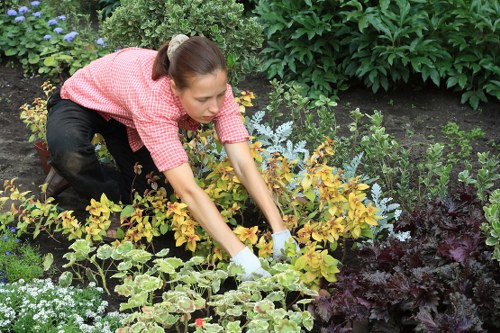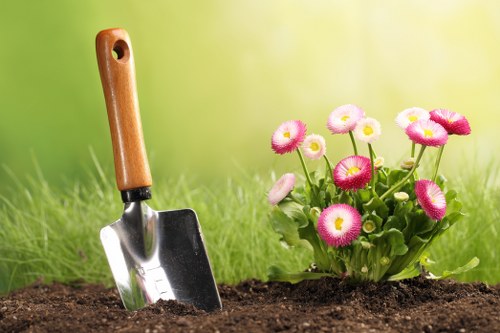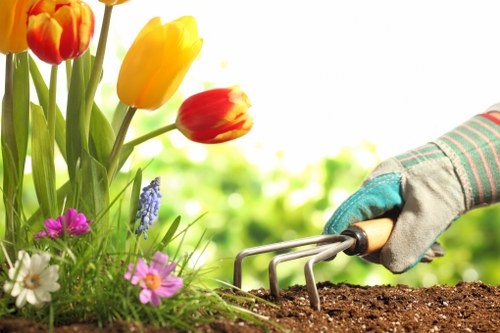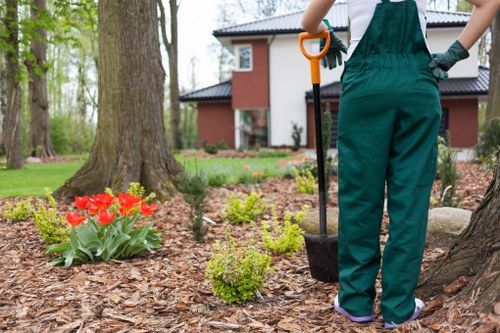Comprehensive Garden Maintenance for Stunning Landscapes

Maintaining a beautiful garden landscape requires dedication, knowledge, and the right techniques. Garden maintenance in garden landscape gardeners is essential to ensure that your outdoor space remains vibrant, healthy, and welcoming throughout the year.
Regular upkeep not only enhances the aesthetic appeal of your property but also promotes the longevity of your plants and structures. Whether you are a professional gardener or a passionate homeowner, understanding the fundamentals of garden maintenance can make a significant difference.
In this article, we will delve into the key aspects of garden maintenance, providing you with actionable tips and insights to keep your garden in pristine condition.
Essential Garden Maintenance Practices

Garden maintenance encompasses a variety of tasks aimed at preserving the health and beauty of your landscape. Here are some essential practices every gardener should follow:
- Pruning: Regular pruning helps shape plants, remove dead or diseased branches, and encourage healthy growth.
- Weeding: Keeping your garden free from weeds reduces competition for nutrients and water, ensuring your desired plants thrive.
- Mulching: Applying mulch helps retain soil moisture, suppresses weeds, and improves soil quality.
- Watering: Proper irrigation is crucial. Overwatering can lead to root rot, while underwatering stresses plants.
- Fertilizing: Providing essential nutrients through fertilizers supports robust plant growth and vibrant blooms.
Implementing these practices consistently will lead to a well-maintained garden that serves as a peaceful retreat and a visual delight.
Pruning Techniques for Optimal Growth

Pruning is a critical component of garden maintenance that involves selectively removing parts of a plant. Effective pruning promotes healthy growth, enhances airflow, and maintains the desired shape of plants.
Here are some tips for successful pruning:
- Choose the right time: Prune specific plants during their dormant season to minimize stress and encourage vigorous growth in the growing season.
- Use proper tools: Sharp, clean tools reduce the risk of damaging plants and prevent the spread of diseases.
- Understand plant anatomy: Knowing where to make cuts ensures that the plant can heal properly and continue to grow healthily.
- Remove dead or diseased branches: Eliminating these parts prevents the spread of diseases and pests, maintaining the overall health of the plant.
Regular pruning tailored to each plant's needs fosters a lush and orderly garden landscape.
Seasonal Garden Maintenance Tips

Different seasons bring unique challenges and opportunities for garden maintenance. Adapting your maintenance routine to the changing seasons ensures year-round beauty and health of your garden.
Spring: As plants emerge from dormancy, spring is the perfect time for planting new flowers, applying fertilizers, and initiating pruning of certain trees and shrubs.
Summer: Focus on regular watering, mulching, and controlling pests and weeds. Hot weather may require adjusting your irrigation schedule to ensure adequate hydration.
Autumn: Prepare your garden for winter by clearing fallen leaves, dividing perennials, and protecting delicate plants from frost.
Winter: While many plants are dormant, winter maintenance includes planning for the upcoming growing season, maintaining tools, and protecting sensitive plants from extreme cold.
Effective Weeding Strategies

Weeds compete with your garden plants for essential resources, making effective weeding a crucial aspect of garden maintenance. Here are some strategies to manage weeds efficiently:
- Mulching: Applying a layer of mulch suppresses weed growth by blocking sunlight and creating a barrier that weeds find difficult to penetrate.
- Hand Weeding: Regularly removing weeds by hand prevents them from establishing deep roots and spreading throughout the garden.
- Proper Spacing: Planting your garden densely reduces the space available for weeds to grow.
- Use of Weed Barriers: Installing landscape fabric or other barriers can help control weed growth in specific areas.
- Natural Herbicides: Consider using natural weed control methods to manage weeds without harming your garden plants.
Implementing these weeding strategies will maintain the health and appearance of your garden landscape.
Soil Health and Fertilization
Healthy soil is the foundation of a thriving garden. Proper soil maintenance and fertilization ensure that plants receive the nutrients they need to grow strong and vibrant.
Soil Testing: Conduct regular soil tests to determine nutrient levels and pH balance. This information guides appropriate fertilization and soil amendment decisions.
Organic Matter: Incorporate compost or other organic matter into the soil to improve its structure, fertility, and moisture-retention capabilities.
- Benefits of Compost: Compost enriches the soil with essential nutrients, enhances microbial activity, and promotes healthy root development.
- Green Manure: Planting cover crops like clover or rye can add organic matter and nutrients to the soil when turned under.
Maintaining soil health through these practices supports robust plant growth and a resilient garden ecosystem.
Choosing the Right Fertilizers
Selecting the appropriate fertilizer is key to providing your garden plants with the necessary nutrients. Here are some guidelines:
- Understand Plant Needs: Different plants have varying nutrient requirements. Research the specific needs of your garden plants to choose fertilizers that cater to them.
- Types of Fertilizers: Choose between organic and synthetic fertilizers based on your gardening philosophy and the specific needs of your plants.
- Application Rates: Follow recommended application rates to avoid over-fertilizing, which can harm plants and contaminate waterways.
- Frequency: Establish a fertilization schedule that aligns with the growth cycles of your plants, typically applying fertilizers during active growth periods.
Proper fertilization enhances plant health, boosts flowering and fruiting, and maintains the overall vitality of your garden landscape.
Pest and Disease Management
Protecting your garden from pests and diseases is a critical aspect of garden maintenance. Effective management ensures that your plants remain healthy and productive.
Integrated Pest Management (IPM): IPM combines biological, cultural, physical, and chemical control methods to manage pests sustainably.
- Biological Controls: Introduce natural predators, such as ladybugs or predatory mites, to control pest populations.
- Cultural Practices: Rotate crops, maintain garden hygiene, and select pest-resistant plant varieties to reduce pest incidence.
- Physical Barriers: Use nets, fences, or row covers to protect plants from insect pests and birds.
- Chemical Controls: Apply pesticides judiciously, opting for environmentally friendly options when possible.
Early detection and prompt action are essential in preventing the spread of pests and diseases, ensuring a healthy and thriving garden.
Organic Pest Control Methods
Organic pest control methods offer environmentally sustainable alternatives to chemical pesticides. These methods are safer for beneficial insects, pets, and humans.
- Neem Oil: A natural pesticide that disrupts the life cycle of insects, effective against a variety of pests.
- Insecticidal Soaps: These soaps suffocate soft-bodied insects like aphids and mites without harming plants.
- Companion Planting: Growing certain plants together can repel pests and attract beneficial insects. For example, planting marigolds alongside vegetables can deter nematodes.
- Handpicking: Regularly inspect plants and manually remove pests to reduce their numbers.
- Beneficial Insects: Encourage the presence of natural predators, such as bees, butterflies, and predatory beetles, to maintain a balanced ecosystem.
Incorporating these organic pest control methods helps maintain a healthy garden environment without relying on synthetic chemicals.
Watering and Irrigation Systems
Proper watering is essential for maintaining plant health and ensuring a vibrant garden landscape. An efficient irrigation system can save time and resources while promoting consistent plant hydration.
Types of Irrigation Systems:
- Drip Irrigation: Delivers water directly to the plant roots, minimizing evaporation and water waste.
- Sprinkler Systems: Ideal for covering larger areas, providing uniform water distribution.
- Soaker Hoses: Allow water to seep through the hose material, providing gentle and consistent moisture to plants.
Watering Best Practices:
- Water Early in the Day: Reduces evaporation and allows plants to dry before evening, minimizing the risk of fungal diseases.
- Deep Watering: Encourages deep root growth, making plants more resilient to drought conditions.
- Monitor Soil Moisture: Use soil moisture sensors or simply check the soil by hand to determine when watering is needed.
- Adjust for Weather: Modify your watering schedule based on rainfall and seasonal changes to avoid overwatering.
Implementing effective watering and irrigation practices ensures that your garden receives the necessary hydration to flourish.
Rainwater Harvesting
Rainwater harvesting is an eco-friendly approach to watering your garden. Collecting and storing rainwater reduces dependence on municipal water supplies and conserves this precious resource.
- Rain Barrels: Simple containers that collect and store rainwater from rooftops, providing a sustainable water source for your garden.
- Rain Gardens: Designed to capture and absorb rainwater runoff, reducing erosion and improving water quality.
- Storage Capacity: Ensure that your rainwater storage system has adequate capacity to meet your garden's watering needs, especially during dry periods.
- Maintenance: Regularly clean and inspect your rainwater harvesting system to prevent contamination and ensure efficient operation.
Incorporating rainwater harvesting into your garden maintenance plan promotes sustainability and reduces your environmental footprint.
Lawn Care and Maintenance
A well-maintained lawn enhances the overall appearance of your garden landscape. Proper lawn care involves regular mowing, edging, aeration, and fertilization.
Mowing Techniques:
- Optimal Height: Maintain the grass at the recommended height for its species to encourage healthy growth and discourage weeds.
- Sharp Blades: Use a sharp mower blade to make clean cuts, reducing stress on the grass and preventing disease.
- Mowing Frequency: Adjust mowing frequency based on grass growth rates, typically once a week during the growing season.
Additional Lawn Care Tips:
- Edging: Define the boundaries of your lawn with clean edges to create a neat and polished look.
- Aeration: Aerate your lawn annually to improve soil compaction, allowing better water and nutrient penetration.
- Overseeding: Plant grass seed to fill in bare spots and maintain a dense, lush lawn.
Consistent lawn maintenance ensures a healthy, vibrant green space that complements your garden landscape.
Dealing with Lawn Pests
Lawn pests can cause significant damage if not managed effectively. Identifying and controlling these pests is crucial for maintaining a healthy lawn.
- Grub Control: Grubs feed on grassroots, leading to brown patches. Use beneficial nematodes or appropriate insecticides to control grubs.
- Chinch Bug Management: Chinch bugs suck the sap from grass blades, causing yellowing and wilting. Maintain proper lawn care practices to reduce infestations.
- Armyworm Control: Armyworms can rapidly defoliate lawns. Apply targeted treatments when populations are detected early.
- Preventative Measures: Encourage natural predators and maintain a healthy lawn to reduce the likelihood of severe pest outbreaks.
Effective pest management preserves the integrity and beauty of your lawn, contributing to an overall well-maintained garden.
Hardscape Maintenance
Hardscape elements, such as paths, patios, fences, and garden structures, play a vital role in garden aesthetics and functionality. Proper maintenance of these features ensures their longevity and enhances the overall landscape.
- Cleaning: Regularly clean hardscape surfaces to remove dirt, moss, and algae. Use appropriate cleaning agents to avoid damaging materials.
- Repairs: Inspect for cracks, chips, or other damages and perform necessary repairs to maintain structural integrity and appearance.
- Weed Control: Prevent weeds from growing between paving stones or through cracks by using weed barriers or herbicides.
- Sealing: Apply sealants to surfaces like stone or concrete to protect against weathering and staining.
- Maintenance of Garden Structures: Inspect and maintain structures such as pergolas, arbors, and trellises to ensure they remain safe and attractive.
Maintaining hardscape features complements the natural elements of your garden, creating a balanced and harmonious landscape.
Seasonal Hardscape Care
Different seasons require specific hardscape maintenance tasks to address weather-related wear and tear.
- Spring: Clean and inspect hardscape surfaces, repair any winter damage, and prepare outdoor furniture and structures for use.
- Summer: Monitor for heat-related damage and ensure that pathways and patios remain clear and safe for use.
- Autumn: Remove fallen leaves and debris to prevent staining and moss growth. Seal any cracks that may have developed.
- Winter: Prevent ice damage by managing snow and ice accumulation. Protect garden structures from extreme cold.
Adapting your hardscape maintenance routine to the seasons ensures that these elements remain functional and attractive year-round.
Enhancing Garden Aesthetics
Beyond basic maintenance, enhancing garden aesthetics involves thoughtful design and creative touches that make your garden a true reflection of your style and preferences.
- Plant Selection: Choose plants that complement each other in color, texture, and size to create a cohesive and visually appealing garden.
- Color Coordination: Use a color palette that harmonizes with your home and surroundings, creating a pleasing visual impact.
- Garden Art: Incorporate sculptures, fountains, or decorative elements to add character and interest to your garden.
- Lighting: Use outdoor lighting to highlight key features, create ambiance, and extend the usability of your garden into the evening hours.
- Seating Areas: Create comfortable and inviting spaces where you can relax and enjoy your garden.
By focusing on these aesthetic enhancements, you can transform your garden into a stunning and inviting outdoor sanctuary.
Creating a Wildlife-Friendly Garden
A wildlife-friendly garden attracts beneficial creatures such as birds, butterflies, and pollinators, contributing to a balanced and vibrant ecosystem.
- Native Plants: Planting native species provides food and habitat for local wildlife, supporting biodiversity.
- Water Sources: Incorporate birdbaths, ponds, or water features to provide essential hydration for animals.
- Shelter: Create shelters using shrubs, logs, or dedicated wildlife structures to offer protection and nesting sites.
- Avoid Pesticides: Reducing or eliminating pesticide use ensures that beneficial insects and animals remain unharmed.
- Food Sources: Plant flowers that provide nectar and fruit to attract pollinators and birds.
Encouraging wildlife in your garden not only enhances its beauty but also supports natural pest control and ecosystem health.
Professional Garden Maintenance Services
While DIY garden maintenance is achievable, professional garden maintenance services offer expertise and efficiency that can elevate your garden to new heights.
- Expertise: Professional gardeners possess extensive knowledge of plant care, landscape design, and maintenance techniques.
- Time-Saving: Hiring professionals frees up your time, allowing you to enjoy your garden without the stress of upkeep.
- Customized Plans: Professionals can create tailored maintenance plans that address the specific needs of your garden.
- Advanced Equipment: Access to specialized tools and equipment ensures thorough and effective maintenance.
- Year-Round Care: Professional services provide consistent maintenance across all seasons, ensuring your garden remains pristine.
Engaging professional garden maintenance services ensures that your landscape receives the highest level of care, resulting in a beautiful and well-maintained garden.
Choosing the Right Garden Maintenance Service
Selecting the right garden maintenance service involves considering several factors to ensure you receive quality care for your landscape.
- Experience and Expertise: Look for services with a proven track record and knowledgeable staff who understand various gardening techniques.
- Comprehensive Services: Choose a provider that offers a wide range of services, from basic lawn care to specialized plant treatments.
- Customer Reviews: Read testimonials and reviews to gauge the satisfaction levels of previous clients.
- Licensing and Insurance: Ensure the service is properly licensed and insured to protect against any potential liabilities.
- Customized Plans: Select a service that can tailor their offerings to meet the unique needs of your garden.
By carefully evaluating potential garden maintenance services, you can find a reliable partner to keep your garden landscape in optimal condition.
Conclusion
Effective garden maintenance in garden landscape gardeners encompasses a wide range of practices aimed at preserving and enhancing the beauty and health of your outdoor space. From essential maintenance tasks like pruning and weeding to seasonal care, soil health, and pest management, each aspect plays a crucial role in maintaining a thriving garden.
Moreover, incorporating aesthetic enhancements and considering professional maintenance services can elevate your garden to a stunning and sustainable landscape. By following the tips and strategies outlined in this article, you can ensure that your garden remains a vibrant and inviting sanctuary for years to come.
Ready to transform your garden? Contact us today to book your garden maintenance service and experience the difference a professionally maintained landscape can make!



